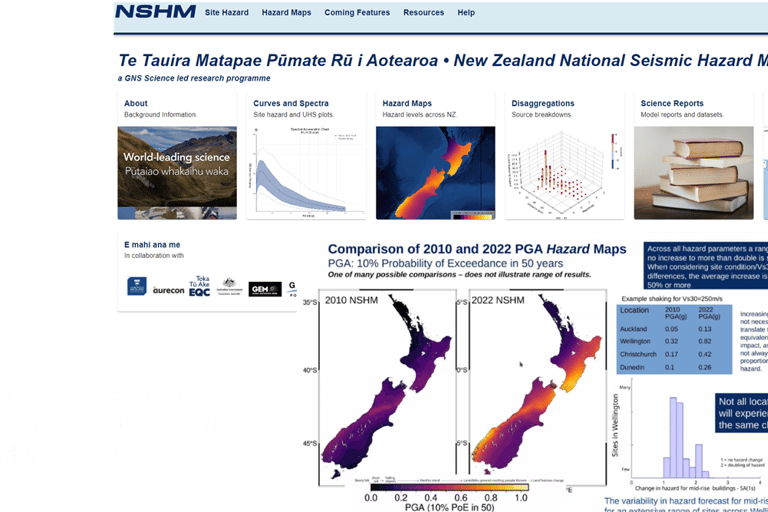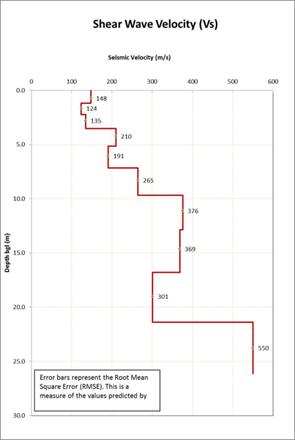What is a Vs30 - and why should I care?
April 4, 2025
Focus on seismic resilience in New Zealand has reached a new peak in recent years, exacerbated by the release of the new National Seismic Hazard Model which saw some areas of the country’s earthquake shaking hazard increase by more than 50% from previous modelling (GNS 2022).
Revised New Zealand National Seismic Hazard Model October 2022 (GNS Science).
This has triggered proposed changes to the New Zealand Technical Specification TS1170.5:2024 (still in public consultation draft) which intends to put a laser focus on Vs30 testing practices for Seismic Site classification in New Zealand. This is proposed to replace the traditional varied methods of identifying “depth to hard” outlined in the existing NZS1170.5:2004 standard – including methods such as calculating fundamental site period. This has led to Vs30 to be proposed as the key Seismic Site Classification metric moving forward.
So what is a Vs30? Simply put, its definition is;
“the time-averaged shear wave velocity (Vs) over the top 30 m of the sub surface profile”
with a shear wave velocity being a fundamental mechanical property of soils and rocks, and directly related to seismic response.
This one metric approach does provide more clarity to identifying sub-soil site class- for example it may enable traditional deep soil sites across the country which have historically always been a class “D” or “E” to have a higher classification based on true soil density and strength. Conversely, the new approach does now also require rock strength profiles to be taken into consideration- so previously shallow rock class “A” or “B” sites may be downgraded to a lower classification based on rock density and strength.
Unfortunately, however, you can’t go to your local geophysical contractor and book in a Vs30 test. There are multiple methods of obtaining a Vs30, with constraining factors including;
· Testing method robustness
· Data resolution
· Budget
· Expected Geology
· Site layout, buried services and topography
· Testing Logistics
Testing can be broadly split into two categories – Intrusive and Non-Intrusive testing. By definition, it simply splits methods into those requiring ground disturbance and those leaving the ground undisturbed.
Intrusive methods are often preferred as they are “direct – measure” (and so more accurate), but often these investigations are also more costly as they require a Drill- or CPT- rig. Non-intrusive methods are often faster and cheaper to perform, but are indirect measures (and so derived measurements), have a lower resolution, are more susceptible to seismic noise and require a lot more site considerations like size, services, access etc.
Intrusive methods are covered by Seismic Cone Penetration Test (sCPT), Seismic Dilatometer (sDMT), downhole seismic (DH Seismic) and borehole wireline logging methods like P&S Suspension logging and Full Waveform Sonic logging. These methods are usually undertaken to the ASTM D7400-17 standards. All intrusive methods propagate shear-waves either at ground level or at depth to a sensor at different depths to build a Shear-wave velocity profile.
Example of a downhole seismic shear wave velocity profile.
Non-intrusive methods are covered by Multi-channel Analysis of Surface Waves (MASW) along with Microtremor Array Measurements (MAM). Both of these are surface wave methods, with MASW requiring an active seismic source and MAM using passive seismic noise sources. Both methods utilise seismic geophones deployed along the ground surface to measure Rayleigh and Love waves, with the dispersive nature of the surface waves being analysed to derive a Vs at various depths based on the different frequencies representing different depths.
Example of a MASW 2d cross section.
However, not all testing methods are equal. You need a good understanding of your site and budget to choose the most robust method. An understanding of the expected geology of the site, along with constraints with each method should be considered before choosing a testing method.
Example 1: if you are considering a Seismic CPT technique, the termination depth of the test should be investigated. If this is likely to be well short of 30 m, then a borehole downhole seismic technique may be required.
Example 2: if you have a large greenfield site with no services which appears ideal for a surface seismic technique (a combined MASW/MAM array), however the site is next to a busy highway. Significant seismic noise can affect surface techniques, so a consideration may be to perform the testing at night or with traffic management to mitigate seismic noise, which may have budget implications.
In summary, geotechnical consultants should have a good understanding on the various testing methods for Vs30, and the corresponding limitations. Geophysics Ltd intends to make this knowledge freely accessible to industry, in order to ensure engineers have the toolkit they need to be able to ensure they maximise the returns on their geophysical investments. Geophysical testing is a powerful tool- however as with any other cutting edge technology when used, its success relies on it wholly being understood correctly.






